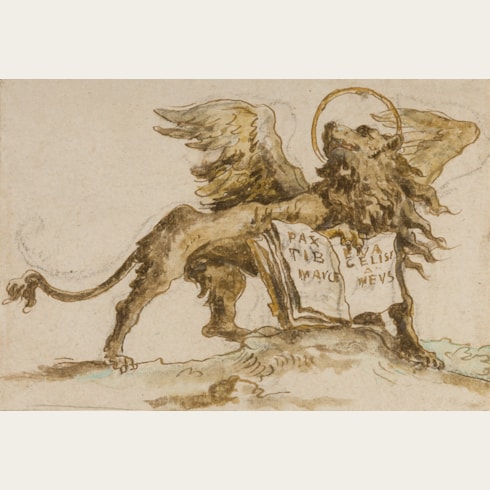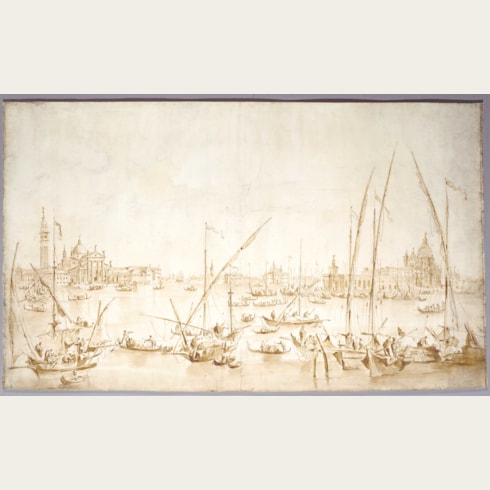Francesco GUARDI
(Venice 1712 - Venice 1793)
A Capriccio with Antique Ruins, a Pyramid and Two Figures
Inscribed Francescho Guardi in the lower left margin of the old mount.
Further inscribed F. Guardi Born at Venice, 1712 – died, 1793. and numbered 5A33 on the verso of the old mount.
298 x 215 mm. (11 3/4 x 8 1/2 in.)
In his survey of Guardi’s drawings, published in 1951, James Byam Shaw noted that the artist’s imaginary landscape studies ‘may be described as the Romantic Capriccio – the idyllic landscape. A ruined tower or a ramshackle farmhouse by the lagoon, a Roman arch or colonnade, dilapidated and overgrown; the long span of an unparapeted bridge; a pyramid, a stone lion, a pair of crossed fir trees, a leaning umbrella-pine; fisher-folk, washerwomen, riders on strange unshapely horses, men digging for buried treasure or relics of antiquity – these are the stock-in-trade here, recurring again and again in innumerable combinations...So far as we need seek their inspiration in the work of other artists, it is [Francesco] Zuccarelli and [Giuseppe] Zais, surely, who provided the inspiration for the more pastoral elements, and Marco Ricci and [Antonio] Visentini for the classical, the antiquarian flavour. All of these were popular in Venice, and all were older than Guardi…Such influences there may be in Guardi, but in general his method of composing these Romantic Capricci is entirely individual, and their manner of draughtsmanship most personal and suggestive.’
Last exhibited in 1964 and unknown to most scholars, including Antonio Morassi, the present sheet is a fine and fresh example of Guardi’s capriccio landscape drawings. Such drawings are, as Byam Shaw has pointed out, perhaps the artist’s most individual works: ‘It was in the Capriccio that Guardi, more than Canaletto, found the type of subject which, I fancy, pleased him most…If I were asked to guess what picture or drawing might have been Guardi’s favourite among his own work, I would choose some small Capriccio, in which the subject seems perfectly suited to his own spirit and his own technique…It is only in the case of the many Capricci that one feels that he was drawing for the sake of drawing – inventing, imagining, composing, above all enjoying himself. Often, of course, he must have gone through his portfolios, and chosen one of these from which to paint a sparkling little panel or canvas. But the impression remains that such drawings were made independently, however slight they might be – as exercises, perhaps, but not as studies for paintings. These dangle before our eyes the key to the painter’s heart, and offer us a glimpse of his own private world.’
A related painting of the same composition by Guardi, with several differences - notably in the staffage and the form of the church in the right background - is in the Victoria and Albert Museum in London. The main motifs in this drawing, namely the arch and the pyramid beyond, are also found in the broader composition of a drawing of A Capriccio with a Ruined Classical Colonnade and a Pyramidin the former Royal Museum in Canterbury, and another capriccio drawing that was in a private collection in Paris in 1973, as well as in a small sketch formerly in the collection of Count Antoine Seilern and today in the Courtauld Gallery in London. As the second of these drawings has been described, in terms equally appropriate to the present sheet, ‘The scene, which is permeated by a disquieting preromantic feeling, with its disparate architectural elements on which time has decidedly left its mark, its disconnected fragments of marble and stone, its foliage stirred by a gentle breeze, its abandoned sculpture, its brook, its bridge, has been continuously interpreted by Guardi with remarkable inventiveness and intense lyricism.’
A ruined arch with foliage - akin to those often seen in the work of the architectural painter Antonio Visentini, as well as in some landscapes by Marco Ricci - appears as a frequent motif in Guardi’s capriccio subjects, both in paintings and drawings, over a period of several decades. The arch seen in this drawing also appears, for example, in a capriccio painting by Guardi in the Museo Poldi Pezzoli in Milan, as well as in a related pen and ink drawing in the Museo Correr in Venice.
As the art historian and museum curator Michael Levey has noted, ‘The artist Guardi increasingly became, in the second portion of his career, was hardly classifiable. View pictures and caprices merge as categories in paintings that are imbued with intense response to Venice but less for its bricks and mortar, or its inhabitants, than for its watery setting, its scattered islands, its sense of illimitable distance and silence amid crumbling fragments of ruin or in an isolated boat floating between the sea and sky. What Guardi seeks to capture, one might think, was the intangible essence – almost, the idea – of Venice.’
Born in East Prussia, Werner Gramberg (1896-1985) was an art historian and collector. He completed a doctorate on the sculptor Giambologna in 1928, and worked at the State Museums in Berlin, with a sabbatical at the Bibliotheca Hertziana in Rome from 1932 to 1933. In 1934, however, he was forced to leave his post in Berlin because his wife was part Jewish. He settled permanently in Hamburg in 1945, and in 1949 was named curator of the numismatic collections of the Kunsthalle there, and from 1951 to 1960 was head of the sculpture collection and Deputy Director of the Kunsthalle. In 1957 he took up a post as professor of art history at Hamburg University. An expert in Italian Renaissance art, he published widely, including such works as Die Düsseldorfer Skizzenbücher des Guglielmo della Porta, published in 1964. Gramberg was a co-founder of the Stiftung zur Förderung der Hamburgischen Sammlungen, and worked actively within the foundation until his death in 1985. His extensive collection included an important group of sculptures, paintings and drawings, many of which were bequeathed to the Kunsthalle in Hamburg. This fine drawing by Francesco Guardi, however, remained in his family’s collection until recently.
By 1761 Guardi had joined the painter’s guild in Venice, and soon established a reputation as a painter of Venetian views and imaginary landscapes, or capricci. He enjoyed a market for his views of Venice, painted with loose, spirited brushwork and transparent washes which allowed the artist the freedom to explore atmospheric effects. While he was fairly successful as a view painter, Guardi never achieved the level of fame enjoyed by Canaletto, particularly among foreign visitors to Venice. Nevertheless, his work was popular with British tourists to the city, and among his patrons was the English diplomat John Strange, the British resident in Venice between 1773 and 1790, who commissioned a series of view paintings of country villas on the terraferma. It was not until 1784, at the age of seventy-one, that Guardi was admitted to the Accademia in Venice, as a ‘pittore prospetico’. His son Giacomo was also an artist, and continued the family studio well into the 19th century.
As Rudolf Wittkower has written, ‘Francesco Guardi’s art has often been compared with the music of Mozart. Despite his modernity, Guardi was a man of his century and, more specifically, a man of the Rococo. He continued creating his spirited capriccios and limpid visions of Venice long after the spectre of a new heroic age had broken in on Europe. When he died in the fourth year of the French Revolution, few may have known or cared that the reactionary backwater of Venice…had harboured a great revolutionary of the brush.’
A gifted draughtsman, Guardi was a prolific and spirited master of the pen. (Antonio Morassi listed over 650 drawings by the artist in his catalogue raisonné of 1984.) As has been noted, ‘There was something of Watteau in his make-up; he was seldom without a sketchbook at hand in which to jot down anything that took his fancy whether or not it was used in a painting later on.’ Guardi’s drawings include sheets of studies of figures and boats, architectural scenes, designs for wall and ceiling decorations, landscape capricci and topographical Venetian views. ‘By 1765 or so’, as another scholar has written, ‘Guardi had developed his personal style, in which a nervous, flickering line and subtly and richly varied washes give an atmospheric brilliance and luminosity that transform the subject into pictorial enchantment.’
A large and varied collection of drawings by the artist is today in the Museo Correr in Venice, acquired by Count Teodoro Correr from Giacomo Guardi. These are, however, mostly sketches and quick studies for pictures, rather than large-scale, finished sheets, and as such represent the typical contents of an artist’s workshop. Smaller but significant collections of drawings by Guardi are today in the British Museum and the Courtauld Gallery in London, the Pierpont Morgan Library and Metropolitan Museum of Art in New York, the Ashmolean Museum in Oxford and the Louvre in Paris.
Provenance
Thence by family descent until 2020.
Literature
Exhibition










